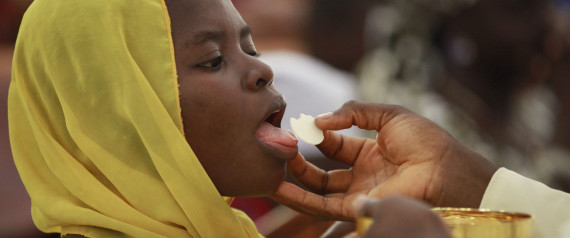A couple of months before he died, Archbishop Fulton J. Sheen was interviewed on national television. One of the questions he was asked was this: "You have inspired millions of people all over the world. Who inspired you? Was it a pope?" He responded that it was not a pope, cardinal, another bishop, or even a priest or nun, but rather an eleven-year-old Chinese girl.
He explained that when the communists took over China, they imprisoned a priest in his own rectory near the church. After being locked up in his own house, the priest looked out the window and was horrified to see the communists enter the church. Once inside, they went into the sanctuary, broke open the tabernacle and in a hateful act of desecration, threw down the ciborium scattering the Hosts on the floor. The priest knew exactly how many Hosts had been in the ciborium: thirty-two.
When the communists left they either didn't notice, or didn't pay any attention to a small girl praying in the back of the Church who saw everything. That night she returned, and slipping past the guard at the rectory, entered the Church where she made holy hour perhaps of reparation for the desecration she witnessed of the Blessed Sacrament.
After her holy hour she went into the sanctuary, and kneeling down, she bent over and received Jesus in Holy Communion with her tongue.
Each night, the girl returned to the church to make her holy hour and receive Jesus in Holy Communion on her tongue just as she did the first night.
On the thirty-second night, after having consumed the last Host, she accidentally made a noise that awoke the guard who was asleep at his post by the priest's residence. From his bedroom window, the priest could only watch in horror as the heartrending scene unfolded before his eyes. The girl tried to run away but the guard caught up with her and beat her to death with the butt of his rifle.When Bishop Sheen heard the story he was so inspired that he promised God he would make a holy hour before the Blessed Sacrament every day for the rest of his life. And he was not only faithful to his promise, but he took every opportunity to spread this devotion of the daily holy hour before the Blessed Sacrament.
We don't know the name of the eleven-year-old Chinese girl of our story, but her heroic act of going to the church every night at the risk of her life to adore and receive Jesus in the Blessed Sacrament serves as a powerful testimony against the attitude of so many Catholics today who show nothing but callous indifference toward the Real Presence of Our Lord Jesus Christ in the Holy Eucharist.
An excerpt from Treasure In Clay, The Autobiography of Fulton J. Sheen:
"I resolved also to spend a continuous Holy Hour every day in the presence of Our Lord in the Blessed Sacrament . . . The Holy Hour. Is it difficult? Sometimes it seemed to be hard; it might mean having to forego a special engagement, or rise an hour earlier, but on the whole it has never been a burden, only a joy . . . . The purpose of the Holy Hour is to encourage a deep personal encounter with Christ. The holy and glorious God is constantly inviting us to come to Him, to hold converse with Him, to ask for such things as we need and to experience what a blessing there is in fellowship with Him . . . I have found that it takes some time to catch fire in prayer. This has been one of the advantages of the daily hour. It is not so brief as to prevent the soul from collecting itself and shaking off the multitudinous distractions of the world. Sitting before the Presence is like a body exposing itself before the sun to absorb its rays. Silence in the Hour is a tete-a-tete with the Lord. In those moments one does not so much pour out written prayers, but listening takes its place. We do not say:"Listen, Lord, for Thy servant speaks,"but "Speak, Lord, for Thy servant heareth."



1 comment:
"When the bee has gathered the dew of heaven and the earth's sweetest nectar from the flowers, it turns it into honey, then hastens to its hive. In the same way, the priest, having taken from the altar the Son of God (who is as the dew from heaven, and true son of Mary, flower of our humanity), gives him to you as delicious food." - St. Ephraem
Post a Comment